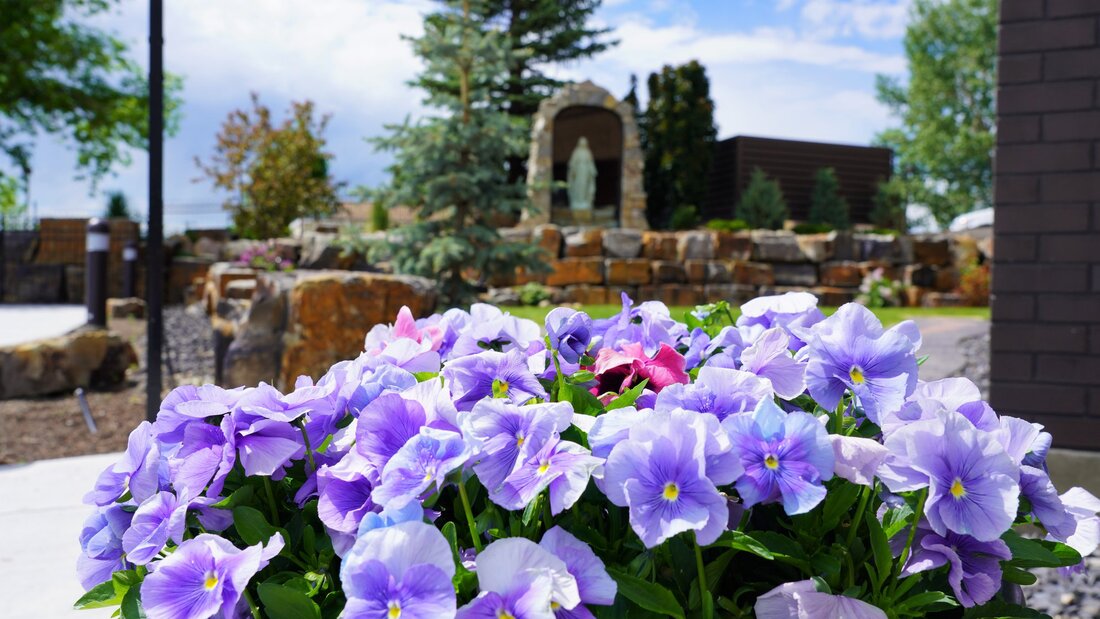|
With climate change getting so much media coverage, it’s easy to see why some Catholics are asking questions about what they can do to support the papal call for Christians to unite in caring for what Pope Francis calls, “our common home.” Other Catholics don’t spend much time thinking about it. They’re too busy planting, weeding and harvesting food, flowers—and faith. This summer, volunteers planted a 3,000-square-foot vegetable garden at the Mount St. Francis Retreat Centre at Cochrane. The potatoes, carrots, squash and swiss chard were put to good use; the food is shared between Feed the Hungry’s (FTH) Sunday dinners at St. Mary’s Cathedral and the Calgary Food Bank. “The food bank really is a ‘bank,” says Linnea Ferguson, program lead for the Calgary Catholic Diocese’s FTH program. “We take from that bank for our Sunday night dinners, so it’s nice to deposit some food there, too.” Although FTH is more closely aligned with social versus environmental causes, the connection between food and life is obvious, notes Ferguson. “By actively participating in the production of local produce, I think Feed the Hungry shows care for our common home and how much we respect the dignity of the people we feed.” Care for Creation Over at St. Joseph’s parish in northwest Calgary, parish council has adopted some care for creation initiatives sparked by the 2015 papal encyclical, Laudato Si: On Care for Our Common Home. This spring, Knights of Columbus planted a courtyard area with plants donated by a long-time parishioner. “It’s really beautiful,” says parish council member Marilou LeGeyt. “We’ve got a variety of flowering plants, including roses, monkshood and black-eyed Susan. Next year, the Knights will divide those plants and sell the extras as a fundraiser.” After all the planning and planting were done, the project yielded three wins for the parish. The garden is a fundraiser, a beautiful space by the Church entrance and its gives parishioners an opportunity to take an ecological piece of their church community home to their own gardens. In late September, the courtyard hosted a Blessing of the Animals. The event attracted dogs, fish, cats and turtles! In line with Laudato Si and its focus on dialogue, St. Joseph’s parish is also exploring the addition of a vegetable garden on the church property. The concept is meant to nourish St. Joe’s place in the wider community, says LeGeyt. At St. Peter’s parish, a team of volunteer gardeners is taking responsibility for the gardens built as part of a major reconstruction project. Led by parishioner Sylvie Fung, who’s also active with the Society of St. Vincent de Paul, the grounds include several well-kept flower pots, ground-level plots and a new grotto. The latter includes an outdoor rosary. To help the growing number of faithful who visit the space to pray, Fung tucks several rosaries and prayer cards into two solar lamps at the garden entrance. “People take the rosaries, so I’m always looking for more,” says Fung. Members of her garden team take turns watering the pots and checking to make sure the freshly-landscaped shrubs and perennials are doing well. But the job can get a little prickly. While the space between the church and alley has been beautifully landscaped, these beds include a number of Canada Thistle, an invasive (not Canadian!) weed species known for its thorns and deep roots, both of which complicate eradication. Fung encourages her fellow gardeners to weed these “beds of thorns, beds of suffering” as an act of faithful sacrifice. “It’s the perfect job to recite the Chaplet of Divine Mercy,” says Fung with a smile. Written by Joy Gregory for Faithfully
0 Comments
Your comment will be posted after it is approved.
Leave a Reply. |
Author
Catholic Pastoral Centre Staff and Guest Writers Archives
July 2024
Categories
All
|






 RSS Feed
RSS Feed